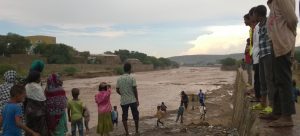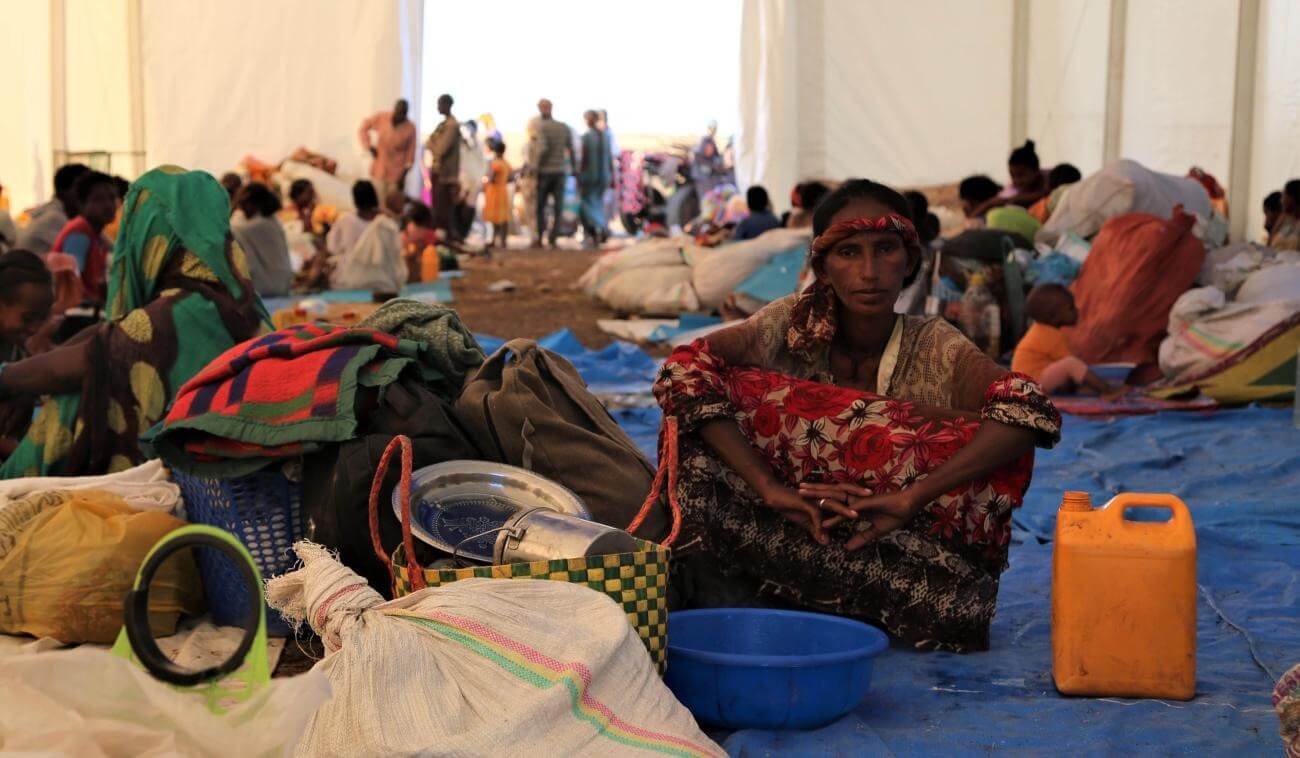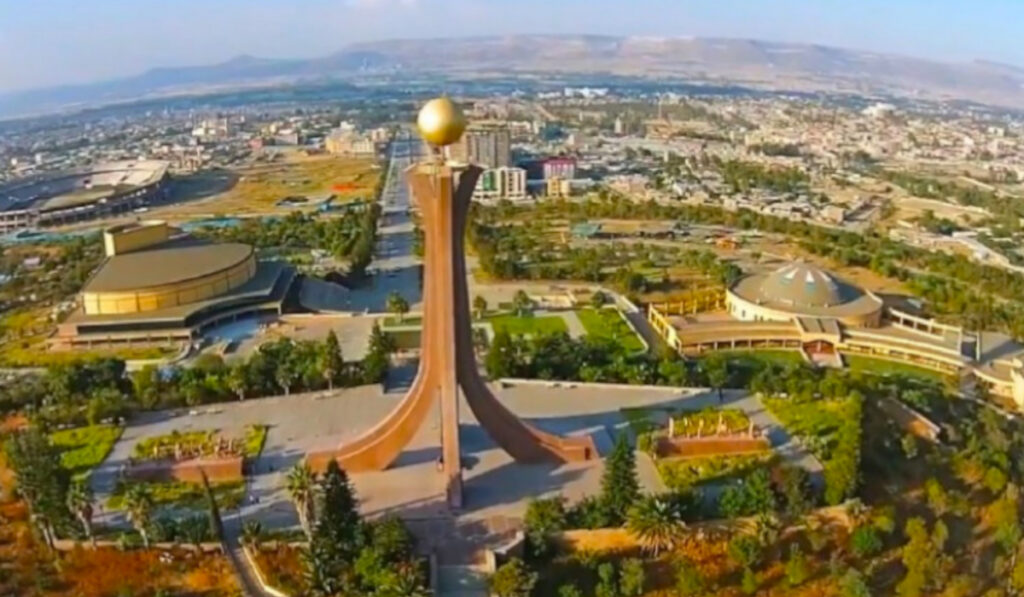Dire Dawa: From El Niño to La Niña
Tesfalem Waldyes
Dire Dawa – For residents of Dire Dawa, a city 515 km East of Addis Abeba, mid-day on May 12, 2016 was not the usual break time. Residents who were on their way home for lunch were forced to stop when they reached the big waterway that divides the city into two parts. Dire, as residents fondly call the city, was once again under the spell of heavy floods and the city police department was frantically trying to dispatch its members throughout the town to prevent anyone from approaching various crossing points of the riverbed.
Within minutes residents of the city spread the news that what they always dread has once again hit their city. In 2006, Dire Dawa had witnessed the death of 256 of its residents to a heavy flood. Since then its resident live in fear that the next time will be their turn. The anxiety is more persistent on those residing around the banks of the river.
“If the flooding happened at night, many people would have definitely died,” Abdu Mohammed, a driver who lives near a river bank told Addis Standard, recalling the 2006 incident. The August 2006 torrential rain caused the nearby Dechatu River to outburst from the banks and flooded the city around mid-night.
The flood retaining walls built along the banks ten years ago did little to give residents a sense of protection and security; they were the first ones to come crumbling down at the first sign of the floods, the third flash floods in just 10 days only in May.
Dire’s residents now know that with the rainy season around the corner their ordeals may be ahead of them.
Prone city
The second most populous city in Ethiopia, Dire Dawa lies at the bottom of mountain ranges and is widely known for being a flood prone city. Flash floods are the inevitable outcomes whenever a heavy rain pours down at the surrounding highland areas within five kilometers radius. Although the city does not have Perennial River flowing within its turf, its four major watercourses that cross it or pass in the outskirt and the boundary always bring problems during every rainy season.
Like many parts of Ethiopia, Dire Dawa too receives two rainy seasons a year – the short rainy season of February – May and the long rainy season of July – September. This rainfall pattern, however, was disrupted for the last two years due to the unprecedented weather change brought by El Niño, a global climate event that heavily disrupted Ethiopia’s 2015 spring and summer rains.
The current El Niño induced drought has already exacerbated food insecurity, malnutrition and water shortages throughout Ethiopia affecting, by some estimates, as high as 18 million people. Dire Dawa and its surrounding were designated among the most vulnerable areas affected by the drought, which is the worst Ethiopia is experiencing in over 50 years.
Dire Dawa from El Niño to La Niña
It was while struggling to overcome the El Niño induced drought that Dire Dawa and its environs were suddenly forced to prepare for another extreme climatic condition – La Niña, a weather condition that brings in the opposite impacts of El Niño in a form of flooding.
Dire Dawa is not alone. During the month of May floods and landslides have again hit cities and towns in Somali, Oromia, Afar, Amhara, Harari and Southern regions. Many of these areas were severely affected by the recent drought. By mid-May, around 100 people were reported to have been killed due to floods and landslides, according to a Briefing Note by Assessment Capacities Project (ACAPS), a project specializing on humanitarian assessment and analysis. On July 4, Adama, a city 100km south of the capital Addis Abeba, became the latest victim when an overnight torrential rain left parts of the city inundated.
In Dire Dawa alone reports showed that the flooding in May claimed the lives of at least three people while some parts of the Afar region, which lies along the mid and down-stream plains of the Awash River, were totally covered by the flood and were only accessible using helicopters.
The National Disaster Risk Management Commission (NDRMC), a government agency that handles emergencies, was forced to borrow a military helicopter to reach the people in these areas. (NDRMC often rejects the idea of having its own helicopter for emergency reasons mentioning the running cost as a reason). In mid-May, Addis Standard also witnessed four broken bridges on a single road that stretches from Chfra to Semera, the capital of Afar.
The recent floods have also caused significant displacement of households and people. At least 19,000 households and 200,000 people were displaced by flooding across the country, according to s situation report by the United Nations Office for the Humanitarian Affairs (OCHA) released in the beginning of June. Citing the National Flood Task Force, the Situation Report predicted that at least half a million would be affected by river overflows and flash floods.
“Flooding in Ethiopia is mainly linked with torrential rainfall and the topography of the highland mountains and lowland plains with natural drainage systems formed by the principal river basins,” NDRMC’s June 2016 Flood Alert stated. “In most cases floods occur in the country as a result of prolonged heavy rainfall causing rivers to overflow and inundate areas along the river banks in lowland plains.”
But independent reports that study recurrent flood patterns in the country suggest the country to look into the root causes of the problem. A study that examined the 2006 Flood Disaster in Ethiopia, which all in all killed more than 700 people in various parts of the country, says that “apart from rainfall, environmental conditions along with management practices have significantly contributed the devastating impact of floods.”
“The issue of flood has now become increasingly an issue of management and planning of water resources,” the study prepared by the local Environmental NGO, Forum for Environment (FFE), stated.
“Integrated water resource management in Ethiopia is not in advanced stage. Flood management being an integral part of integrated water resources management has not been treated separately on a sustainable manner.”
In the case of Dire Dawa, the study advised authorities to look into the factors that caused and triggered flooding processes and flood disasters. Environmental degradation in catchment areas, increasing trend of settlement and human intervention on a flooding zone as well as lack of adequate flood protection measures are the factors raised in the study.
Large-scale deforestation in the surrounding highlands has aggravated the rate of flooding in Dire Dawa, the study further stated. Arbitrary practices of cutting trees within catchment areas have significantly increased the level of soil erosions while massive degradation of vegetation often lead to flash floods even for short duration of rainfall.
In addition, absence of runoff shields in upland areas also give velocity to the river water when reaching the city. This, coupled with the narrowed channel of the riverbed, has pressurized the excessive water forcing it to outburst its banks and flood the city. The study pointed out that incessant human intervention in existing flooding zones has significantly narrowed the river channel.
In the shadow of the past
Italians, during their occupation of Ethiopia between 1935 -41, first delineated the flooding zone in Dire Dawa. Low income residents of the city were forced to settle on the most vulnerable parts of the flooding zone and the City Administration was made to give green cards for the construction of huge infrastructures like the Bottling Factory of Coca Cola and Dire Dawa’s main Bus Terminal within the flooding zone.
The ever shortening frequency of flooding is another headache for Dire Dawa. The first well-recognized flash flood in Dire Dawa was recorded as early as 1945, according to the study by FFE. But the second one hit the city after a gap of 32 years followed by the third in just span on four years in 1981.
Sixteen years later in 1997 Dire Dawa was inundated with yet another severe flood followed by the 2004 and 2006. Since then, Dire Dawa is experiencing floods of various magnitudes on a yearly base forcing city residents to spend sleepless nights.
Ten years after the FFE study tabled its recommendations that could have potentially curb flooding problems in Dire Dawa and other parts of the country flooding remained the constant nightmare for millions of Ethiopians.
This year the National Flood Task Force predicted that floods would affect at least half a million people in several parts of the country and the people of Dire Dawa, who have sustained the 2006 tragic incident that not only killed 256 people but also affected more than 647,000, are at the forefront of the receiving end.
Photos: Tesfalem Waldyes/Addis Standard









